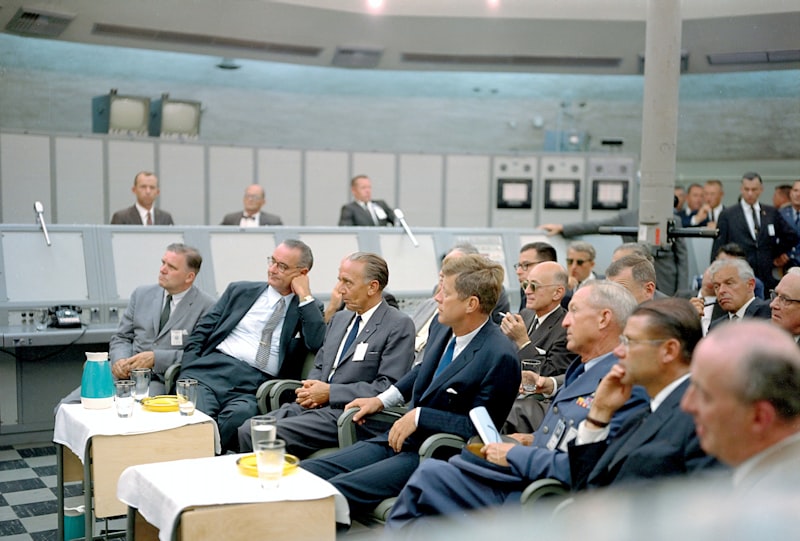
One of the most memorable instances was during the Great Depression when President Franklin D. Roosevelt took office in 1933. Faced with a staggering unemployment rate and widespread poverty, Roosevelt implemented his New Deal programs aimed at providing relief, recovery, and reform. His fireside chats over the radio reassured a despairing nation, bringing hope and unity during a time of uncertainty.
Another pivotal moment came during World War II, when President Franklin D. Roosevelt and later President Harry S. Truman navigated the country through one of the deadliest conflicts in human history. Roosevelt’s steady leadership and Truman’s decision to drop atomic bombs on Hiroshima and Nagasaki brought an end to the war, albeit amidst controversy.
Fast forward to the 21st century, the September 11 attacks presented a new kind of crisis for President George W. Bush. His administration responded with the War on Terror, including the invasion of Afghanistan and Iraq, aiming to dismantle terrorist networks and safeguard the homeland.
In more recent times, the COVID-19 pandemic emerged as a global health crisis of unprecedented scale. President Barack Obama’s successor, President Donald Trump, faced criticism for his handling of the pandemic, while President Joe Biden focused on accelerating vaccination efforts and providing economic relief.
Each crisis has tested the resolve of the nation and its leaders. From Roosevelt’s bold policies during the Great Depression to Bush’s response to terrorism and Biden’s efforts against COVID-19, U.S. Presidents have consistently been at the forefront of steering the country through adversity.
From Lincoln to Biden: Evolutions in Presidential Crisis Management
Presidential crisis management has evolved significantly from the time of Abraham Lincoln to Joe Biden. Each era brings unique challenges and demands, shaping how leaders respond to crises that define their administrations.
Abraham Lincoln, facing the tumultuous Civil War, navigated the nation through its darkest hour with steadfast resolve and visionary leadership. His approach emphasized national unity and moral clarity, setting a precedent for presidential crisis management rooted in resilience and empathy.
Fast forward to the modern era, where Joe Biden grapples with a diverse array of challenges, from global pandemics to economic uncertainties. Unlike Lincoln’s era, today’s crises unfold in real-time under intense media scrutiny and public opinion. Biden’s approach integrates rapid response strategies with digital communication tools, ensuring transparency and accountability in crisis management.
The evolution from Lincoln’s era to Biden’s administration highlights not only technological advancements but also shifts in public expectations and governance dynamics. Where Lincoln utilized speeches and printed media to rally support, Biden leverages social media platforms and live broadcasts to engage directly with citizens.
In navigating crises, both presidents prioritize decisive action and clear communication. Lincoln’s eloquence and moral authority resonated across the nation, while Biden’s accessibility and empathy foster a sense of unity and shared responsibility. Each leader’s crisis management style reflects the zeitgeist of their respective eras, adapting to the evolving complexities of global interconnectedness and rapid information dissemination.
As history unfolds, the lessons of past presidents continue to shape contemporary crisis management strategies. Lincoln’s legacy of resilience and moral clarity echoes through the corridors of power, influencing how leaders like Biden approach challenges with compassion and resolve. The evolution from Lincoln to Biden underscores the enduring principles of leadership amidst adversity, where each crisis becomes an opportunity to unite and strengthen the nation.
Breaking Down Roosevelt’s New Deal and Its Impact on National Crises
At its core, Roosevelt’s New Deal was a multifaceted approach to tackle the devastating effects of the Great Depression. It included relief programs to provide immediate aid to the millions of unemployed and struggling Americans, such as the Civilian Conservation Corps (CCC) and the Works Progress Administration (WPA). These initiatives not only put people back to work but also revitalized the nation’s infrastructure through the construction of roads, bridges, and public buildings.
Moreover, the New Deal introduced reforms aimed at preventing future economic collapses. The establishment of the Securities and Exchange Commission (SEC) sought to regulate the stock market and prevent fraud, while the Federal Deposit Insurance Corporation (FDIC) restored confidence in banks by insuring deposits. These measures aimed to stabilize the financial system and restore public trust.
In addition to its economic impact, the New Deal had profound social consequences. Programs like Social Security provided a safety net for the elderly and disabled, fundamentally altering the relationship between the government and its citizens. Meanwhile, agricultural subsidies and labor protections aimed to alleviate rural poverty and improve working conditions across various industries.
Critics argue over its effectiveness, but there’s no denying the New Deal’s enduring legacy. It marked a significant shift towards a more active role of the federal government in the nation’s economy and welfare. Its impact resonates through generations, influencing subsequent social policies and shaping the modern American welfare state.
Roosevelt’s New Deal was more than just a series of programs; it was a paradigm shift in American governance and society. Its legacy continues to spark debates on the role of government in times of national crises and remains a testament to bold, transformative leadership in the face of adversity.
Crisis Leadership: How JFK Handled the Cuban Missile Crisis
Kennedy’s first strategic move was to establish a team of trusted advisors, creating the Executive Committee of the National Security Council (ExComm), which included top military, diplomatic, and intelligence officials. This diverse group provided Kennedy with a range of perspectives and expertise crucial for evaluating options and formulating a response.
Instead of rushing into a hasty decision, Kennedy opted for a cautious and methodical approach. He ordered a naval blockade, termed a “quarantine,” around Cuba to prevent further Soviet shipments of military supplies and demanded the removal of existing missiles. This measured response aimed to avoid escalating tensions while signaling firm resolve.


Publicly, Kennedy maintained a calm demeanor while privately navigating intense discussions and negotiations. His televised address to the nation on October 22, 1962, informed the American people of the crisis and explained the actions being taken to address it. This direct communication helped rally national support behind his decisions and conveyed a sense of unity and purpose during a time of uncertainty.
Kennedy’s handling of the Cuban Missile Crisis demonstrated adept crisis management characterized by clear communication, strategic thinking, and collaborative decision-making. By leveraging diplomacy and avoiding rash actions, he successfully steered the world away from the brink of nuclear catastrophe. His leadership during those harrowing days has since been studied and admired as a model of effective crisis management and decision-making under pressure.
Obama’s Response to the Great Recession: Lessons for Future Presidents
One of Obama’s key strategies was the implementation of the American Recovery and Reinvestment Act (ARRA) in 2009. This ambitious stimulus package aimed to jumpstart economic growth by injecting $787 billion into the economy through tax cuts, infrastructure projects, and social welfare programs. The goal was to create jobs, stabilize financial institutions, and restore confidence in the markets.
Obama’s approach was multifaceted, focusing not only on short-term recovery but also on long-term structural reforms. He emphasized the importance of regulatory oversight to prevent future financial crises, advocating for the Dodd-Frank Wall Street Reform and Consumer Protection Act. This legislation aimed to increase transparency in the financial sector, curb risky practices, and protect consumers from predatory lending.
Moreover, Obama’s response highlighted the importance of international cooperation in addressing global economic challenges. He worked closely with other world leaders through the G20 summits to coordinate stimulus efforts and financial regulations on a global scale, underscoring the interconnected nature of the modern economy.

Critics of Obama’s response argued that the recovery was slow and uneven, with persistent challenges in employment and income inequality. However, proponents pointed to sustained economic growth throughout much of his presidency and the eventual decline in unemployment rates as evidence of the effectiveness of his policies.
Obama’s response to the Great Recession offers valuable lessons for future presidents facing economic crises. His emphasis on bold, coordinated action, regulatory reform, and international cooperation provides a blueprint for navigating turbulent economic waters while balancing short-term relief with long-term stability and growth. Understanding these lessons can guide policymakers in formulating proactive and effective responses to future economic challenges.
Trump’s Approach to COVID-19: A Controversial Crisis Management Strategy

Trump’s initial response to the pandemic was marked by a downplaying of the severity of the virus. Early on, he expressed optimism that the situation would resolve quickly, often comparing COVID-19 to the seasonal flu. This stance, while aiming to allay public fears, drew criticism for potentially underestimating the threat posed by the novel coronavirus.
Another pivotal aspect of Trump’s strategy was his emphasis on reopening the economy swiftly. Citing concerns about the economic impact of prolonged shutdowns, he advocated for states to relax restrictions and return to normalcy as soon as possible. This approach resonated with supporters eager to resume their livelihoods but faced opposition from health experts cautioning against premature reopening without sufficient containment measures in place.
Throughout the pandemic, Trump’s administration faced challenges in coordinating a unified national response. Tensions between federal guidelines and state autonomy led to a patchwork of policies across the country, contributing to confusion and disparities in containment efforts.
Trump’s communication style, characterized by frequent press briefings and direct engagement via social media, further fueled controversy. His statements, often unfiltered and provocative, sometimes contradicted public health experts and scientific consensus, creating a polarizing narrative around the administration’s handling of the crisis.
Critics argued that Trump’s approach prioritized political optics over public health imperatives, accusing the administration of downplaying risks and promoting unproven treatments. Supporters, however, praised his efforts to accelerate vaccine development through Operation Warp Speed, a public-private partnership aimed at expediting vaccine production and distribution.
Trump’s approach to COVID-19 emerged as a divisive issue, highlighting the complexities of crisis management in a politically charged environment. His actions, from initial reassurances to later advocacy for economic recovery, continue to be debated as part of the broader discourse on pandemic response strategies.
Frequently Asked Questions
How did U.S. Presidents handle economic crises throughout history?
Learn how U.S. Presidents historically managed economic crises, detailing key strategies and policies employed to stabilize markets, restore growth, and mitigate financial downturns.
How have Presidents responded to public health emergencies in the past?
Learn how past Presidents have addressed public health emergencies, examining their strategies and decisions to safeguard public health and ensure national well-being.
What strategies have U.S. Presidents used to navigate political scandals?
Learn about the various strategies employed by U.S. Presidents to handle political scandals effectively.
How have U.S. Presidents addressed civil rights issues during their terms?
Explore how U.S. Presidents have approached civil rights throughout their terms, tracing pivotal moments from Abraham Lincoln’s Emancipation Proclamation to modern-day policies and actions. Gain insights into the evolution of civil rights legislation and presidential initiatives aimed at advancing equality and justice for all Americans.
What are examples of U.S. Presidents dealing with wartime challenges?
Explore how various U.S. Presidents have navigated wartime challenges, including notable examples of strategic decisions and leadership during critical historical conflicts.


